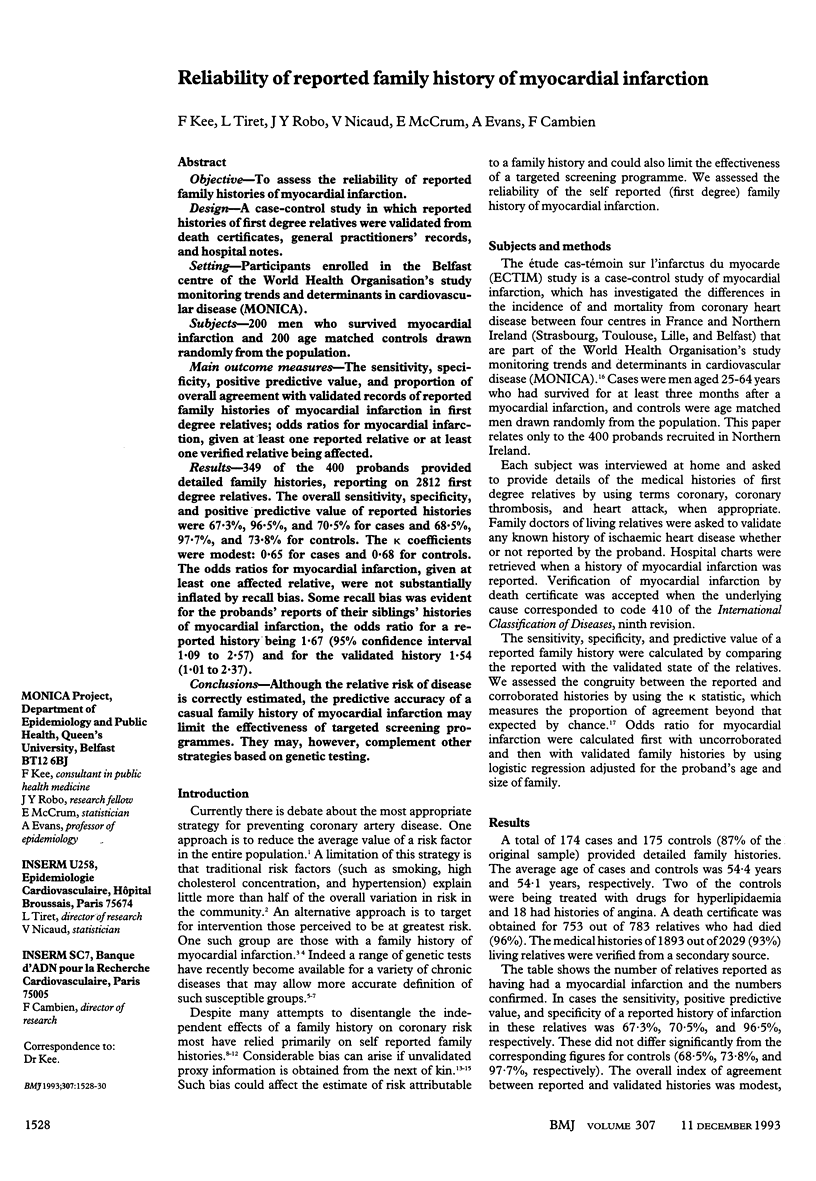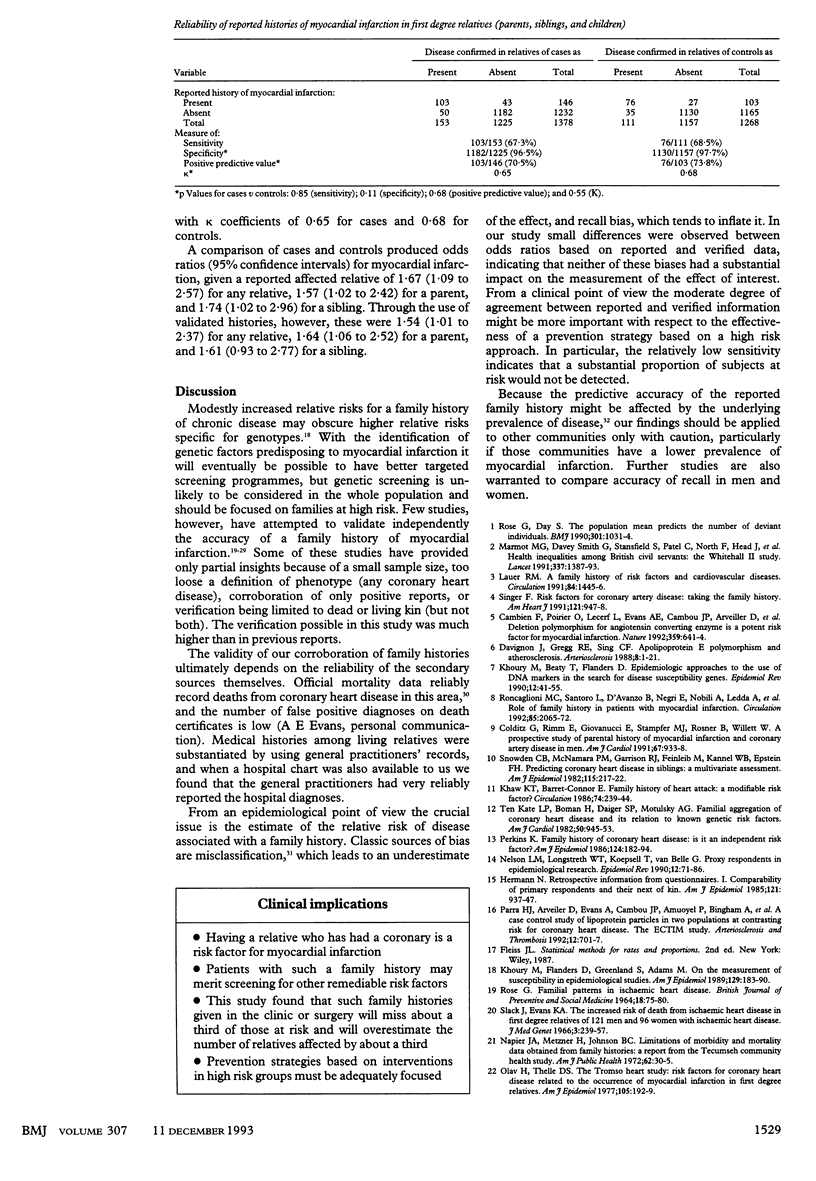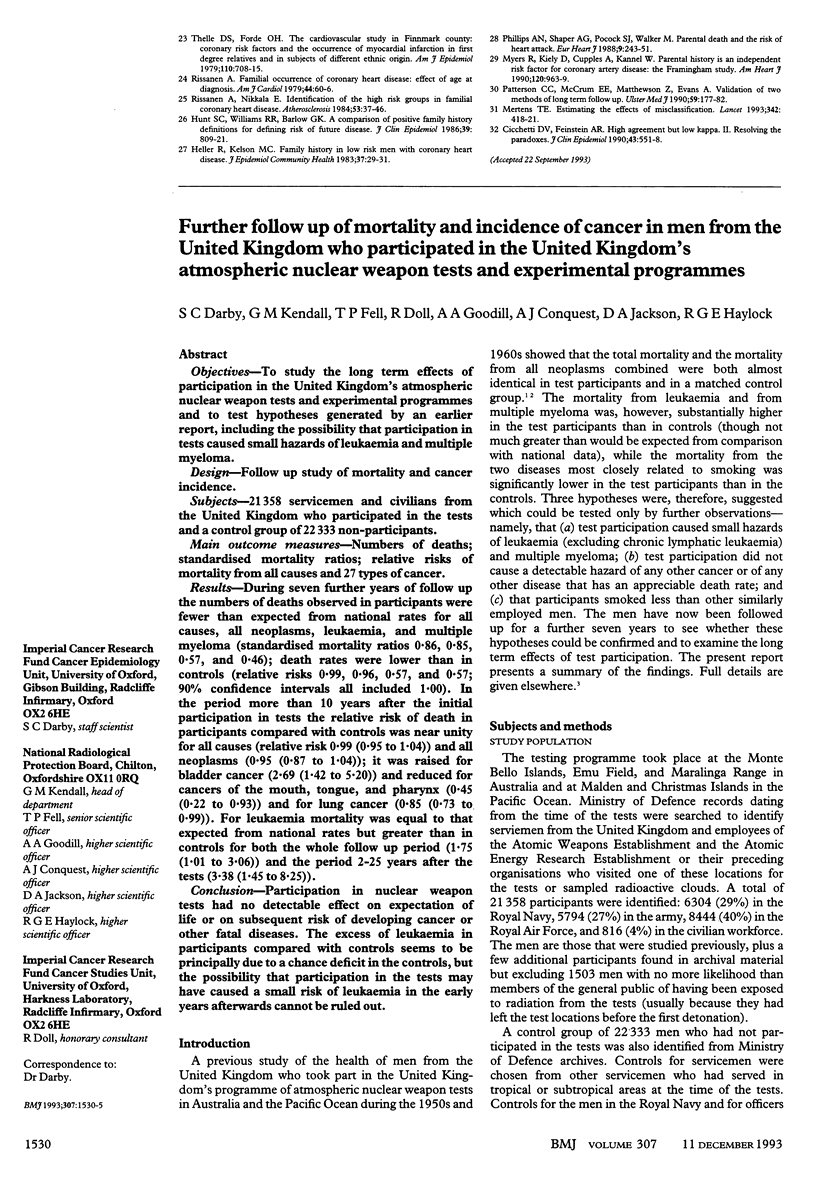Abstract
OBJECTIVE--To assess the reliability of reported family histories of myocardial infarction. DESIGN--A case-control study in which reported histories of first degree relatives were validated from death certificates, general practitioners' records, and hospital notes. SETTING--Participants enrolled in the Belfast centre of the World Health Organisation's study monitoring trends and determinants in cardiovascular disease (MONICA). SUBJECTS--200 men who survived myocardial infarction and 200 age matched controls drawn randomly from the population. MAIN OUTCOME MEASURES--The sensitivity, specificity, positive predictive value, and proportion of overall agreement with validated records of reported family histories of myocardial infarction in first degree relatives; odds ratios for myocardial infarction, given at least one reported relative or at least one verified relative being affected. RESULTS--349 of the 400 probands provided detailed family histories, reporting on 2812 first degree relatives. The overall sensitivity, specificity, and positive predictive value of reported histories were 67.3%, 96.5%, and 70.5% for cases and 68.5%, 97.7%, and 73.8% for controls. The kappa coefficients were modest: 0.65 for cases and 0.68 for controls. The odds ratios for myocardial infarction, given at least one affected relative, were not substantially inflated by recall bias. Some recall bias was evident for the probands' reports of their siblings' histories of myocardial infarction, the odds ratio for a reported history being 1.67 (95% confidence interval 1.09 to 2.57) and for the validated history 1.54 (1.01 to 2.37). CONCLUSIONS--Although the relative risk of disease is correctly estimated, the predictive accuracy of a casual family history of myocardial infarction may limit the effectiveness of targeted screening programmes. They may, however, complement other strategies based on genetic testing.
Full text
PDF


Selected References
These references are in PubMed. This may not be the complete list of references from this article.
- Cambien F., Poirier O., Lecerf L., Evans A., Cambou J. P., Arveiler D., Luc G., Bard J. M., Bara L., Ricard S. Deletion polymorphism in the gene for angiotensin-converting enzyme is a potent risk factor for myocardial infarction. Nature. 1992 Oct 15;359(6396):641–644. doi: 10.1038/359641a0. [DOI] [PubMed] [Google Scholar]
- Cicchetti D. V., Feinstein A. R. High agreement but low kappa: II. Resolving the paradoxes. J Clin Epidemiol. 1990;43(6):551–558. doi: 10.1016/0895-4356(90)90159-m. [DOI] [PubMed] [Google Scholar]
- Colditz G. A., Rimm E. B., Giovannucci E., Stampfer M. J., Rosner B., Willett W. C. A prospective study of parental history of myocardial infarction and coronary artery disease in men. Am J Cardiol. 1991 May 1;67(11):933–938. doi: 10.1016/0002-9149(91)90163-f. [DOI] [PubMed] [Google Scholar]
- Davignon J., Gregg R. E., Sing C. F. Apolipoprotein E polymorphism and atherosclerosis. Arteriosclerosis. 1988 Jan-Feb;8(1):1–21. doi: 10.1161/01.atv.8.1.1. [DOI] [PubMed] [Google Scholar]
- Forde O. H., Thelle D. S. The Tromso heart study: risk factors for coronary heart disease related to the occurrence of myocardial infarction in first degree relatives. Am J Epidemiol. 1977 Mar;105(3):192–199. doi: 10.1093/oxfordjournals.aje.a112375. [DOI] [PubMed] [Google Scholar]
- Heller R. F., Kelson M. C. Family history in "low risk" men with coronary heart disease. J Epidemiol Community Health. 1983 Mar;37(1):29–31. doi: 10.1136/jech.37.1.29. [DOI] [PMC free article] [PubMed] [Google Scholar]
- Herrmann N. Retrospective information from questionnaires. I. Comparability of primary respondents and their next-of-kin. Am J Epidemiol. 1985 Jun;121(6):937–947. doi: 10.1093/oxfordjournals.aje.a114064. [DOI] [PubMed] [Google Scholar]
- Hunt S. C., Williams R. R., Barlow G. K. A comparison of positive family history definitions for defining risk of future disease. J Chronic Dis. 1986;39(10):809–821. doi: 10.1016/0021-9681(86)90083-4. [DOI] [PubMed] [Google Scholar]
- Khaw K. T., Barrett-Connor E. Family history of heart attack: a modifiable risk factor? Circulation. 1986 Aug;74(2):239–244. doi: 10.1161/01.cir.74.2.239. [DOI] [PubMed] [Google Scholar]
- Khoury M. J., Beaty T. H., Flanders W. D. Epidemiologic approaches to the use of DNA markers in the search for disease susceptibility genes. Epidemiol Rev. 1990;12:41–55. doi: 10.1093/oxfordjournals.epirev.a036061. [DOI] [PubMed] [Google Scholar]
- Khoury M. J., Flanders W. D., Greenland S., Adams M. J. On the measurement of susceptibility in epidemiologic studies. Am J Epidemiol. 1989 Jan;129(1):183–190. doi: 10.1093/oxfordjournals.aje.a115107. [DOI] [PubMed] [Google Scholar]
- Lauer R. M. A family history of risk factors and cardiovascular diseases. Circulation. 1991 Sep;84(3):1445–1446. doi: 10.1161/01.cir.84.3.1445. [DOI] [PubMed] [Google Scholar]
- Marmot M. G., Smith G. D., Stansfeld S., Patel C., North F., Head J., White I., Brunner E., Feeney A. Health inequalities among British civil servants: the Whitehall II study. Lancet. 1991 Jun 8;337(8754):1387–1393. doi: 10.1016/0140-6736(91)93068-k. [DOI] [PubMed] [Google Scholar]
- Mertens T. E. Estimating the effects of misclassification. Lancet. 1993 Aug 14;342(8868):418–421. doi: 10.1016/0140-6736(93)92820-j. [DOI] [PubMed] [Google Scholar]
- Myers R. H., Kiely D. K., Cupples L. A., Kannel W. B. Parental history is an independent risk factor for coronary artery disease: the Framingham Study. Am Heart J. 1990 Oct;120(4):963–969. doi: 10.1016/0002-8703(90)90216-k. [DOI] [PubMed] [Google Scholar]
- Nelson L. M., Longstreth W. T., Jr, Koepsell T. D., van Belle G. Proxy respondents in epidemiologic research. Epidemiol Rev. 1990;12:71–86. doi: 10.1093/oxfordjournals.epirev.a036063. [DOI] [PubMed] [Google Scholar]
- Parra H. J., Arveiler D., Evans A. E., Cambou J. P., Amouyel P., Bingham A., McMaster D., Schaffer P., Douste-Blazy P., Luc G. A case-control study of lipoprotein particles in two populations at contrasting risk for coronary heart disease. The ECTIM Study. Arterioscler Thromb. 1992 Jun;12(6):701–707. doi: 10.1161/01.atv.12.6.701. [DOI] [PubMed] [Google Scholar]
- Patterson C. C., McCrum E. E., Mathewson Z., Evans A. E. Validation of two methods of long-term epidemiological follow-up. Ulster Med J. 1990 Oct;59(2):177–182. [PMC free article] [PubMed] [Google Scholar]
- Perkins K. A. Family history of coronary heart disease: is it an independent risk factor? Am J Epidemiol. 1986 Aug;124(2):182–194. doi: 10.1093/oxfordjournals.aje.a114377. [DOI] [PubMed] [Google Scholar]
- Phillips A. N., Shaper A. G., Pocock S. J., Walker M. Parental death from heart disease and the risk of heart attack. Eur Heart J. 1988 Mar;9(3):243–251. doi: 10.1093/oxfordjournals.eurheartj.a062492. [DOI] [PubMed] [Google Scholar]
- ROSE G. FAMILIAL PATTERNS IN ISCHAEMIC HEART DISEASE. Br J Prev Soc Med. 1964 Apr;18:75–80. doi: 10.1136/jech.18.2.75. [DOI] [PMC free article] [PubMed] [Google Scholar]
- Rissanen A. M. Familial occurrence of coronary heart disease: effect of age at diagnosis. Am J Cardiol. 1979 Jul;44(1):60–66. doi: 10.1016/0002-9149(79)90251-0. [DOI] [PubMed] [Google Scholar]
- Rissanen A. M., Nikkilä E. A. Identification of the high-risk groups in familial coronary heart disease. Atherosclerosis. 1984 Oct;53(1):37–46. doi: 10.1016/0021-9150(84)90103-5. [DOI] [PubMed] [Google Scholar]
- Roncaglioni M. C., Santoro L., D'Avanzo B., Negri E., Nobili A., Ledda A., Pietropaolo F., Franzosi M. G., La Vecchia C., Feruglio G. A. Role of family history in patients with myocardial infarction. An Italian case-control study. GISSI-EFRIM Investigators. Circulation. 1992 Jun;85(6):2065–2072. doi: 10.1161/01.cir.85.6.2065. [DOI] [PubMed] [Google Scholar]
- Rose G., Day S. The population mean predicts the number of deviant individuals. BMJ. 1990 Nov 3;301(6759):1031–1034. doi: 10.1136/bmj.301.6759.1031. [DOI] [PMC free article] [PubMed] [Google Scholar]
- Singer F. Risk factors for coronary artery disease: taking the family history. Am Heart J. 1991 Mar;121(3 Pt 1):947–948. doi: 10.1016/0002-8703(91)90222-4. [DOI] [PubMed] [Google Scholar]
- Slack J., Evans K. A. The increased risk of death from ischaemic heart disease in first degree relatives of 121 men and 96 women with ischaemic heart disease. J Med Genet. 1966 Dec;3(4):239–257. doi: 10.1136/jmg.3.4.239. [DOI] [PMC free article] [PubMed] [Google Scholar]
- Snowden C. B., McNamara P. M., Garrison R. J., Feinleib M., Kannel W. B., Epstein F. H. Predicting coronary heart disease in siblings--a multivariate assessment: the Framingham Heart Study. Am J Epidemiol. 1982 Feb;115(2):217–222. doi: 10.1093/oxfordjournals.aje.a113293. [DOI] [PubMed] [Google Scholar]
- Thelle D. S., Førde O. H. The cardiovascular study in Finnmark county: coronary risk factors and the occurrence of myocardial infarction in first degree relatives and in subjects of different ethnic origin. Am J Epidemiol. 1979 Dec;110(6):708–715. doi: 10.1093/oxfordjournals.aje.a112851. [DOI] [PubMed] [Google Scholar]
- ten Kate L. P., Boman H., Daiger S. P., Motulsky A. G. Familial aggregation of coronary heart disease and its relation to known genetic risk factors. Am J Cardiol. 1982 Nov;50(5):945–953. doi: 10.1016/0002-9149(82)90400-3. [DOI] [PubMed] [Google Scholar]


